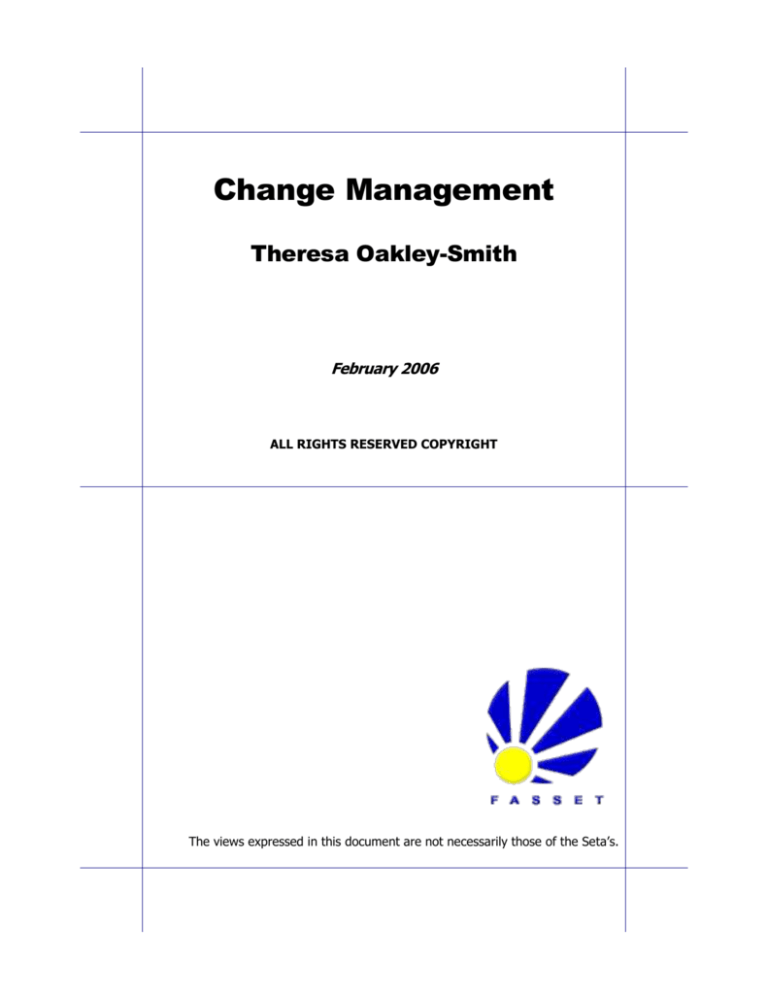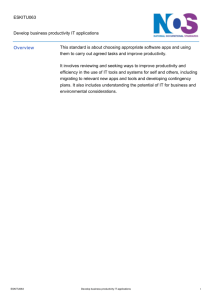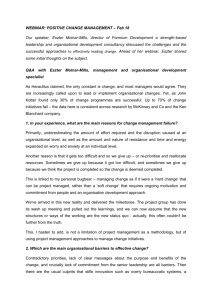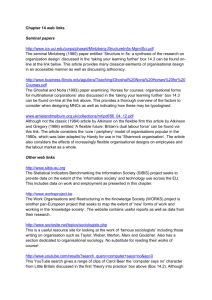
Change Management
Theresa Oakley-Smith
February 2006
ALL RIGHTS RESERVED COPYRIGHT
The views expressed in this document are not necessarily those of the Seta’s.
1. INTRODUCTION
The rate of change is not going to slow down anytime soon. If anything,
competition in most industries will probably speed up even more in the next few
decades”
John Kotter “Leading Change” 1996
There are as many definitions of change as there are approaches to change
management. Change has been a fact of life for many centuries, probably for as
long as human beings have been around. Since about 500 B.C when Heraclites
noted that “the only constant is change” change has been part of the human
condition. During our life times we see change in our bodies, in our lifestyles, we
get married, move house, change jobs have children, change partners, lose
parents. All of these are changes that profoundly affect human beings.
The original meaning of the French word, “changer” was to bend or to turn “like a
tree or a vine searching for the sun”. Today we seem to have lost the
understanding that change is about flexibility. In many organizations change is
seen as a dead end or at least a “T” junction. We need to revert to our earlier
understanding of change as bending, not snapping!
South Africa is currently going through an intense period of change. The changes
in the macro environment (political, social and economic) are affecting the
country as a whole, as well as our companies, teams and ourselves as
individuals. Sometimes we feel helpless in the face of change, powerless to
make a difference. But as Skills Development Facilitators (SDFs) we can
certainly learn how to manage change and play an important role in directing it in
our companies or firms. It is very important that we lead and manage change. If
we don’t manage the change, the change will manage us!
2. WHAT ARE THE DRIVERS FOR ORGANISATIONAL
CHANGE IN SOUTH AFRICA?
The major impetus for organisational change in South Africa is driven by Black
Economic Empowerment (BEE) necessitated by the political changes of the
1990s. The Employment Equity Act and the Skills Development Acts underpin
the necessary changes in organizations. The nature of organisational change is
complex. It involves changes in personnel, bringing in or developing employees
from designated groups; it involves creating changes in the organisational
climate which are supportive of Employment Equity (EE) and Skills Development
(SD). In all of these areas the SDF has an important role to play.
Change Management
1
In learning to manage change in organizations it is vital to understand that
change is something that affects us not only as individuals but also as members
of teams (HR departments,) and as a firm or organization. Of these three
components it is necessary to begin with the self. As the philosopher Thoreau
remarked “Things do not change, we do!” Only when we can understand and
manage internal, personal change will we be in a position to influence or drive a
change management process in our organizations.
3. WHY ORGANISATIONAL CHANGE FAILS
It is sobering to reflect that organisational change is hardly ever sustained
effectively in organizations. Peter Senge, in his book The Dance of Change,
noted that
“Most Change initiatives fail. Two independent studies carried out in the 1990s,
one published by Arthur D Little, and one by McKinsey and Co found that out of
the hundreds of corporate Total Quality Management (TQM) programmes
studied, about two thirds grind to a halt because of their failure to produce the
hoped for results. Reengineering has fared no better…… and even without
knowing the statistics most of us know firsthand that change programmes
fail…..This failure to sustain significant change recurs again and again despite
substantial resources committed to the change effort.”
So what exactly can we do as change agents in our role as SDFs, to make sure
that change does take root in our organizations? How can we ensure that our
company is one of the few which succeeds with a change process?
4. THE 5 STAGE CHANGE PROCESS
Firstly it is imperative to understand the process that we as individuals and our
organizations will take when confronted with change. The seminal work on
“Death and Dying” by Elizabeth Kubler Ross indicated the journey taken by a
bereaved individual and it is precisely this process which we follow when dealing
with change. After all, loss is akin to change as in a change process we loss our
certainties, our old ways of doing things, our familiar connections.
According to Kubler Ross, the change dynamic involves a 5 stage process. The
stages are:
1. Anger
2. Denial
3. Bargaining
Change Management
2
4. Depression
5. Acceptance
All human beings and indeed all organizations must negotiate these five steps in
the process of change. Though the speed with which we negotiate change may
vary and the exact way we experience each phase will be different, nevertheless
we all go through the same process. It is important to remember that change
itself is neutral. There is no such thing as “good change” or “bad change”.
Whether we win the lotto or lose our jobs we still go through the same 5 stage
process in coming to terms with the change.
5. COMMON MISTAKES IN CHANGE MANAGEMENT
Kotter has identified eight common errors that companies make when dealing
with change and the failures experienced by organizations can usually be
attributed to one or a combination of these mistakes.
1.
2.
3.
4.
5.
6.
7.
8.
Allowing too much complacency
Failing to establish a guiding coalition
Underestimating the power of vision
Poor communication of the change process
Allowing obstacles to block the new vision
Failing to create short term wins
Declaring victory too soon
Neglecting to anchor change firmly in the organisational culture
The results of these mistakes are that the desired organisational change never
happens, people revert to old comfortable ways of working and the organization
fails to capitalize on the change opportunity. Specifically Kotter notes five
consequences of the eight common mistakes. These are
1.
2.
3.
4.
5.
New strategies are not implemented well
Acquisitions don’t achieve expected synergies
Reengineering takes too long and costs too much
Downsizing doesn’t control costs
Quality programmes don’t deliver the hoped for results
The challenge in avoiding these mistakes is threefold for your organization.
Firstly it means you as the SDF need to understand why you or your organization
resists change. Secondly you need to understand the five stage process that
underpins all of your efforts and thirdly you need to ensure that effective
leadership guides your efforts.
If you or your organization has experienced unsuccessful or even failed changes
you will probably feel resentful or angry at being confronted again with a need for
Change Management
3
change. You may notice this resentment or anger in colleagues when you
attempt to introduce change. This is very natural. As Kotter states:
“They become suspicious of the motives of those pushing for transformation;
they worry that major change is not possible without carnage; they fear that the
boss is a monster or that much of the management is incompetent”.
In fact in South Africa we have a powerful model for change within our own
country. Often referred to as a miracle, the change that happened in 1990/1994
mirrors the five stage process of Kubler Ross and was very carefully led and
managed. In the same way organisational change needs to be well managed and
well led. The processes of management and leadership are very different but
both need to be evident in successful change.
6. WHAT IS THE ROLE OF SDF IN THE CHANGE
PROCESS
The Skills Development Facilitator has a very important role to play in helping
organizations to change. The role involves a complex process of commitment,
communication and monitoring. Firstly it is critical that the SDF is committed to
the change envisaged by the company. Without commitment it is impossible for
the SDF to play an effective role in driving change. Commitment is primarily
personal and involves the SDF in a process of understanding and accepting
change in order to “walk the talk”.
The second aspect of the role of the SDF is the important one of communication
or education. Unless everyone in the company is informed about change and
how it is envisaged there is no possibility of effective buy-in. This means the SDF
must be prepared to develop an effective education strategy around the change
process and be prepared to educate all within the organization about it. In order
to work well it is strongly recommended that this education process is aligned
with EE or SD strategy of the organization so that change education is integrated
with organisational change and development.
Finally the SDF must be prepared to monitor and assess the process of
organisational change. Again the EE report and the Annual Training Report
(ATR) and Workplace Skills Plan (WSP) should provide benchmarks for
measuring and monitoring change.
Change Management
4
7. HOW CHANGE AFFECTS SELF ESTEEM
Just as there is a predictable staged process of coping with change so it is
possible to anticipate changes in ones self esteem and in the organization’s
organisational morale as a result of being challenged with change. The diagram
below shows how change affects self esteem.
Initially change is usually met with a degree of immobilization. One becomes
frozen. “This can’t be happening to me, there must be some mistake!” This is
rapidly followed by denial as the self esteem tries to protect oneself from the loss
that change brings. Thereafter the stage of depression follows, this is presented
as a profound sense of sadness in the individual and as a lowering of morale and
concomitant productivity in the organization.
The next step is the dawning of acceptance for the self esteem during which one
begins to test out new behaviours and lifestyles. During this step the organization
begins to implement new ways of operating, new systems, organisational
behaviours and strategies. This stage is followed by a search for meaning within
the broader context which involves a rethinking of organisational communication
and branding. The final step in the process of self esteem changes involves
internalizing the change so that it becomes part and parcel of organisational
behaviour.
Change Management
5
SELF-ESTEEM LEVELS
SELF-ESTEEM
CHANGES DURING TRANSITIONS
2. Disbelief
1.Immobilization
(shock/frozen)
3. Depression
4. Acceptance of
reality ( letting go)
Beginning of change transition
TIME
(source: Liz Clarke “The Essence of Change”)
Change Management
6
8. HOW CHANGE AFFECTS PRODUCTIVITY
It is important for the SDF to be aware of changes in productivity brought about
by change and these should be explained in the communication/education
process. Productivity, like self esteem follows a predictable course during the
change process.
THE
PRODUCTIVITY CURVE
PRODUCTIVITY
Productivity Increases
Previous
Situation
Productivity returns to
previous levels
Change
TIME
(source: Liz Clarke “The Essence of Change”)
If one considers the relationship between productivity and time during the
process of change the first result of introducing change will be a drop in
productivity. This is caused by the uncertainty, fear of loss and unfamiliarity of the
envisaged change. It is important that this drop in productivity is anticipated by
the management because otherwise it can result in the change process being
Change Management
7
aborted in which case the organization will anyway revert to stage one in the
process. A drop in productivity in the initial stages is therefore to be expected.
Providing the change is well managed the organization should find that within a
relatively short period productivity should return to pre-change levels. Thereafter
it should exceed the original productivity levels.
9. DEALING WITH RESISTANCE TO CHANGE
The SDF should understand resistance to change in its various manifestations in
order to guide management in dealing with resistance. Resistance often occurs
when communication or education around change has either been absent or
inadequate causing confusion or uncertainty in the organisational culture. In the
absence of communication, rumours will flourish and therefore an effective
communication strategy should spell out just what the objective of change is; how
it will affect employees; how it will affect customers or providers and how its
success will be measured.
Otherwise resistance is often manifested by employees who feel they have
something to lose from the change process. The SDF should resist the
temptation to give unrealistic assurances in this instance and should rather act as
a sounding board.
It is also useful to allow and encourage discussion which deals with the negative
impact of change so that fears and concerns can be brought into the open and
managed.
It is extremely useful if the SDF can identify in advance potential sources of
resistance. In this instance she should try to ensure that a “likely resistor” will be
part of the guiding coalition established by the company.
It is also very important to provide some incentive for employees to change and
in this instance the SDF can assist management by looking at incentive
strategies and rewards.
10. HOW CAN WE ANCHOR
ORGANISATIONAL CULTURE
CHANGE
IN
THE
Organisational culture is extremely complex and impossible to manipulate.
Change in organisational culture follows change in the individual, change in the
behaviour of employees and after some benefit from change is realized.
Change Management
8
Both attitude and behaviour change typically occur early on in the change
process according to John Kotter.
“These alterations then create changes in practices that help a firm produce
better results or services at lower costs. But only at the end of the change cycle
does most of this become anchored in the culture”.
In anchoring change in the culture Kotter points us to five key issues and these
should guide the SDF in terms of her role as change agent.
1.
2.
3.
4.
5.
Change in culture comes last not first
It depends on results
It requires a lot of explanation
It may involve turnover of staff
It makes decisions on succession crucial
11. CONCLUSION: MANAGE THE CHANGE, DON’T LET
IT MANAGE YOU!
As we have seen, perhaps the defining reality of business today in South Africa
is change. All South African companies are experiencing unprecedented
transformation and change. In order to be useful in your organisation you have
an important part to play in helping to manage the process of change so that it
adds value to your organisation and its bottom line.
You can do this by understanding the change process itself and the stages
organisations go through in negotiating change. You can develop an effective
communication/education process so that all employees know what to expect
during times of change. You can ensure that any change initiative is part of your
employment equity and people development initiative and finally you can act as a
watchdog for change in your organisation by monitoring and assessing the
process.
Managing change effectively depends on developing a positive corporate attitude
towards change. Reactive companies that simply wait for change to happen to
them will perceive change negatively. Proactive companies that seek to
understand and embrace change will cope and thrive in times of change. You as
the SDF can help your company to develop the necessary awareness and
acceptance to manage change in a proactive way
Change Management
9









